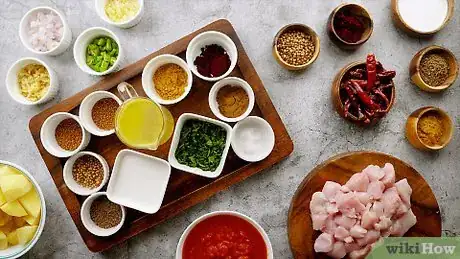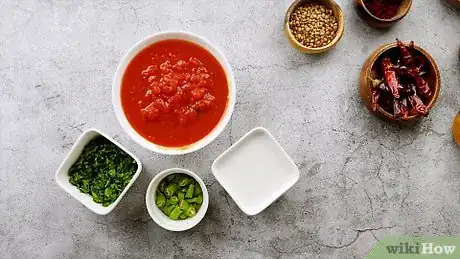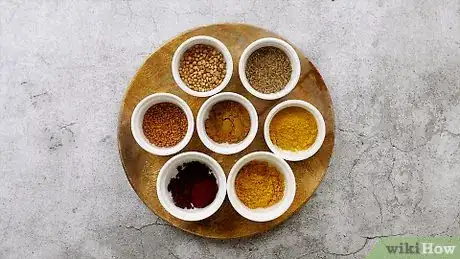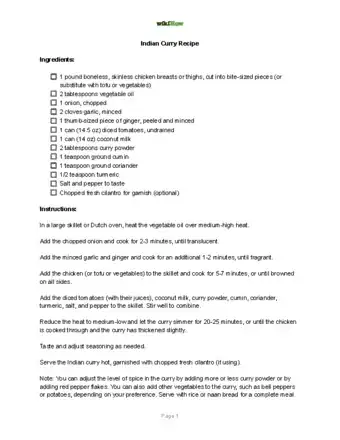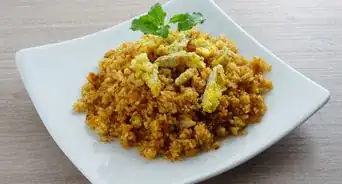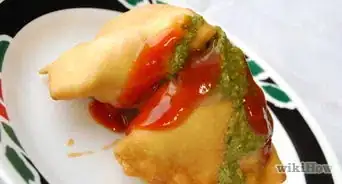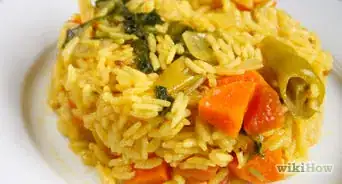This article was co-authored by Ed Kuoha. Ed Kuoha is a Chef and the Owner of Kuoha Culinary based in Aiea, Hawaii. He has more than 20 years of experience in various culinary kitchens and settings such as Morimoto Waikiki, where he received hands-on training from Iron Chef Morimoto. Chef Ed specializes in small catering events and private chef requests. He holds an Associate’s degree from The Culinary Institute of the Pacific at Kapiolani Community College.
wikiHow marks an article as reader-approved once it receives enough positive feedback. This article received 21 testimonials and 100% of readers who voted found it helpful, earning it our reader-approved status.
This article has been viewed 846,772 times.
There are many different types of curry, all of which come down to a few basic ingredients. You start with cooked onion, ginger, and garlic, add generous heaps of spices, and then bring it together with a liquid base. Indian Curry cooking is more about technique than any recipe since the final flavor is dependent on the spices you like and have on hand. Once you get down the basic principles of curry making you'll be whipping up the Indian classics in no time.
- Prep time: 10-20 minutes
- Cook time: 35-60 minutes
- Total time: 55-80 minutes
Steps
The Basics of Curry Making
-
1Understand the basics of any curry making. There are really only 3 important principles to curry creation. Once you have these three things down, you'll be able to easily adapt and customize your curry to your own taste preferences. Simply mix and match ingredients into the following "formula" to get your own curry cooking:
- Onions/Garlic/Ginger: These three ingredients form the basis of most curries, but some Indians actually skip the garlic.[1] The longer you cook these ingredients the richer and darker the curry will be.
- Generous Spices: Curries need big spoonfuls of spices, added early to cook and soften. There is no "wrong" combination of spices, so work on finding the mixtures you love.
- Thickening Agent: What is going to give your curry it's body? This is frequently one or more of the following -- yogurt, coconut milk, stock, water, pureed or diced tomatoes, chili paste, or spinach.[2]
- Other alternatives to thicken curry include mixing flour or using potato starch or cornstarch with water.
-
2Heat oil in a pan on medium heat. You want the oil to be hot and shimmering. You can use whatever oil you'd like, but 1–2 tablespoons (14.8–29.6 ml) of peanut, canola, or vegetable is your best bet.
- For a traditional Indian dish you should use Ghee, also known as clarified butter, for oil.[3]
Advertisement -
3Toss in any aromatic seeds, like coriander, cumin, or mustard, until they begin to crackle. Once the oil is hot, toss in any combination of 1 tablespoon (14.8 ml) coriander/cumin/mustard seeds, fenugreek, and asafoetida, depending on your recipe. Curries are heavily spiced, but also heavily improvised[4] , so feel free to try any combination of spices you'd like.
- For your first recipe, try 1 tablespoon (14.8 ml) cumin and coriander, plus a pinch of asafoetida if you have it.
- Crackling means the seeds are hopping around in the pan, dancing.
-
4Finely chop one onion and add it to the oil. Dice the onion into small, roughly 1/2-inch squares and toss it into the oil. Cook until the edges are translucent and they begin to turn golden, 5-10 minutes.
- The longer you cook the onions, the richer the final curry will be. You can also stop right as they edges turn clear for a lighter yellow curry.[5]
-
5Chop and add the garlic and ginger after the onions have cooked for 3-4 minutes. Finely chop up the 2-inch piece of ginger and 2-3 cloves of garlic, to taste. Add them in to cook and soften with the onions relatively soon after the onions go in. Toss in a pinch of salt, to taste, as they cook.
- Onions, garlic, and ginger are considered the "trinity" of Indian cuisine, much like onions, carrots, and celery are the basic trinity of French cooking.[6]
-
6Toss in generous helpings of ground spices. Curries are heavily spiced dishes, and you need to let the spices cook in with the dish to get the best flavor. Add 1 tablespoon of ground chili powder, cardamom, cayenne pepper, turmeric, cinnamon, and/or curry powder to the oil. Add 1⁄2 tablespoon (7.4 ml) of salt after the spices go in. Stir them in and cook for another 2-3 minutes.
- You want your spices to cook, but not burn. If there is not a lot of liquid in the pan from the onions and oil, mix the spices up with 2–3 tablespoons (29.6–44.4 ml) of water to rehydrate them and prevent burning.[7]
- For your first recipe, try out a tablespoon each of chili powder, turmeric, cardamom, and curry powder.
-
7Add any spicy chilies or flavorings. The longer you cook chilies, the sweeter they become, so add these towards the end of the cooking if you want extra heat. Chop up 2-3 scotch bonnet peppers, Habanero cayenne, Serrano, or finger chilies and toss them in to cook with the onions and garlic, or simply add 1-tablespoon of dried cayenne pepper. with the other spices.
-
8Add your main ingredient -- meat or vegetables -- to start browning. Add 1-2 chopped chicken breasts, shrimp, or lamb to the dish and an extra splash of oil. You can also add vegetables, like 1 can of chickpeas, 2 cups of cauliflower, one eggplant, chopped into 1-inch cubes, chopped pineapple, tomato, or a potato, diced into small cubes.
- If you are adding meat, try browning the outside in a separate pan. Then add it to the curry before moving on.
-
9Add your liquid to cover the ingredients, then cover and cook on medium-low heat. Add any mixture of water, stock, or coconut milk to the ingredients slowly, just until it starts to cover the vegetables and meats. Stir well and cover, lowering the heat to a simmer.
- If you want garam masala in your dish, add 1-tablespoon now. It does not need to cook as long as the other spices.
- For your first recipe, try adding one can of coconut milk for an easy, thicker curry, or 2 cups of vegetable, chicken, or beef stock.
-
10Add your thickening agent, if you desire one. This is the time to add 2 cups chopped spinach (saag), 1 cup of unsweetened yogurt, 1/2-1 cups tomato puree, 2-3 tablespoons chili paste, or even a handful of ground peanuts or almonds. Toss in a pinch of salt as well, to taste.
- Not all curries will need this, especially if you used coconut milk earlier on. You should still experiment with thickening ingredients, especially tomato puree -- the base of red curries.
- For your first curry, try adding 2 tablespoons of tomato puree, then adding more to taste.
-
11Let the curry simmer until your desired thickness. Let the curry cook on low. You'll see the oil and water separate, but this is a good thing. Sample the sauce frequently, adding more salt and spices as desired. This is a good time to add "heat," or spicy flavorings.
- If your curry is too thin, add 2–3 tablespoons (29.6–44.4 ml) of yogurt or tomato puree.[8]
-
12Serve with a garnish of coriander, unsweetened yogurt, crushed nuts, or lemon juice. Curry can stand up to long cooking, so feel free to keep it on low while you finish up other recipes. Just make sure it is hot when you serve it, topped with any accouterments you might enjoy. Serve alone or over a bed of rice.[9]
Adapting Your Curry
-
1Understand how different sauces are created. When you go to an Indian restaurant there are a variety of different dishes that all use the same basic ingredients and technique used in curries. The difference is primarily in thickening agent used:
- Korma uses a creamy agent, like coconut milk, yogurt, or cream.
- Saag uses greens, usually spinach but sometimes mustard/collard greens.
- Madras uses pureed and diced tomato
- Vindaloo uses pureed chilies.[10]
-
2Pulse or blend your ingredients ahead of time for a smoother sauce. This technique, used in many restaurants, creates a curry paste of onions, garlic, ginger, and spices, which cooks faster and results in a smoother curry. To make it, use a food processor to grind everything up into a thick paste, then add it to the hot oil after the seeds have crackled.
-
3Remember that cooking curry is about method, not a specific recipe. There is no one "curry" recipe out there. Curry is about mixing and matching ingredients using curry cooking technique, as outlined above. Still, to make the most basic, run-of-the-mill curry you would add and cook, in this order:
- 3 tablespoons vegetable oil or ghee (clarified butter)
- 1/2teaspoon ground cumin seed
- 1/2teaspoon ground coriander seed
- 1 medium onion - finely chopped
- 4 cloves garlic - peeled and sliced
- 1.5-inch piece ginger - peeled and thinly sliced
- 1/2 teaspoon turmeric powder, curry powder, salt
- 2 mild fleshy green chilies - de-seeded and chopped
- 5 tablespoons tomato puree or 1 tablespoon (14.8 ml) concentrated tomato paste mixed with 4 tablespoons water
-
4Play with the spices you want to add. You should add spices generously, tasting and sampling every chance you get. Start with a tablespoon of any of following, adding more or less to fit your preferences:
- Cumin (essential)
- Coriander (essential)
- Turmeric (essential)
- Ground chili powder
- Cardamom
- Cayenne pepper
- Cinnamon
- Curry powder
- Smoked paprika
- Garam masala
- Asafoetida (just a pinch, also called "thing")
Indian Curry Shopping List and Recipe
Community Q&A
-
QuestionHow do I make curry spicier?
 Community AnswerCumin is the best to add for a stronger typical curry flavor, and garam masala can be added toward the end of cooking for an aromatic lift. For a more savory flavor, add a generous tablespoon of dried fenugreek leaves.
Community AnswerCumin is the best to add for a stronger typical curry flavor, and garam masala can be added toward the end of cooking for an aromatic lift. For a more savory flavor, add a generous tablespoon of dried fenugreek leaves. -
QuestionCan I eat curry with white rice?
 Community AnswerAny rice is OK, but basmati rice is by far the best, both for flavor and cooking times.
Community AnswerAny rice is OK, but basmati rice is by far the best, both for flavor and cooking times. -
QuestionWhat do I feed children who are young and picky?
 Community AnswerAlmost all children love potatoes. You can try potato curry.
Community AnswerAlmost all children love potatoes. You can try potato curry.
Warnings
- Keep it light on the asafoetida/hing; as it quickly gets unpleasant.⧼thumbs_response⧽
References
- ↑ http://www.theguardian.com/lifeandstyle/2014/oct/31/how-to-make-curry-onion-ginger-garlic-mamta-gupta-back-to-basics-henry-dimbleby
- ↑ http://www.theguardian.com/lifeandstyle/2014/oct/31/how-to-make-curry-onion-ginger-garlic-mamta-gupta-back-to-basics-henry-dimbleby
- ↑ http://m.allrecipes.com/recipe/20036/indian-chicken-curry-i/?mxt=t06rda
- ↑ http://www.theguardian.com/lifeandstyle/2014/oct/31/how-to-make-curry-onion-ginger-garlic-mamta-gupta-back-to-basics-henry-dimbleby
- ↑ https://spiceandmore.wordpress.com/2009/08/12/nine-steps-to-make-a-great-indian-curry/
- ↑ http://www.theguardian.com/lifeandstyle/2014/oct/31/how-to-make-curry-onion-ginger-garlic-mamta-gupta-back-to-basics-henry-dimbleby
- ↑ https://spiceandmore.wordpress.com/2009/08/12/nine-steps-to-make-a-great-indian-curry/
- ↑ https://spiceandmore.wordpress.com/2009/08/12/nine-steps-to-make-a-great-indian-curry/
- ↑ http://www.curryfrenzy.com/curry/html/curry-method.html
About This Article
To make Indian curry, start by heating oil in a pan over medium heat. Then, add spices like coriander and cumin and cook them until they begin to crackle. Next, add chopped onion, garlic, and ginger, which are considered the “trinity” of Indian cuisine. When they’ve softened, stir in spoonfuls of spices along with the meat or vegetables. Pour in enough water or stock to cover the ingredients, then let it simmer until everything is cooked through. To learn how to make different curry sauces, scroll down!
